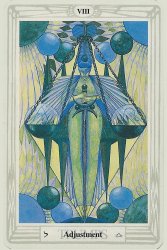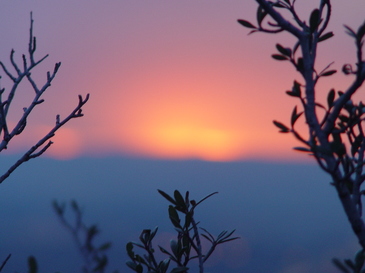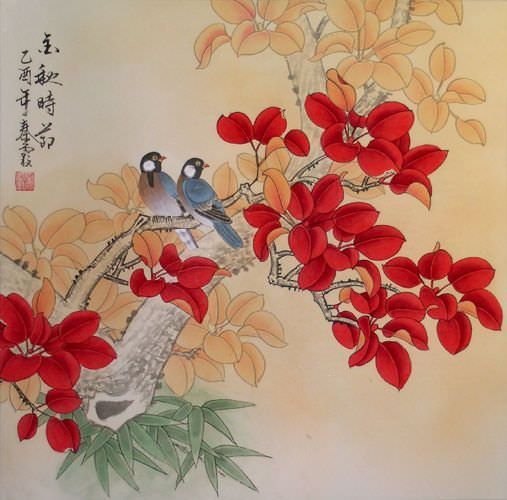 With the eighth trump of the Tarot, we come to the first serious controversy in the deck. The older decks (before Rider-Waite) have Justice as the eighth trump, but A. E. Waite, working from Eliphas Levi's research and ideas, moved Justice to the eleventh trump and moved Strength to the eighth trump. Levi made the move -- and Waite concretized it -- in an effort to make a strict correspondence between the Kabbalah and the Tarot. The correlation is tenuous at best.
With the eighth trump of the Tarot, we come to the first serious controversy in the deck. The older decks (before Rider-Waite) have Justice as the eighth trump, but A. E. Waite, working from Eliphas Levi's research and ideas, moved Justice to the eleventh trump and moved Strength to the eighth trump. Levi made the move -- and Waite concretized it -- in an effort to make a strict correspondence between the Kabbalah and the Tarot. The correlation is tenuous at best.The original eighth trump was Justice because it was a good match for the eighth Hebrew letter (Heth). The symbolism of Heth has to do with the balance struck between the work and efforts of human beings and the destructive forces of nature. The idea of balance in that letter matched the idea of Justice as the balance of power.
 Many modern decks, most notably the Crowley Thoth deck (say what you will about Aleister Crowley, his Book of Thoth is as conservative a presentation of the Tarot as you will find anywhere) have kept the original order of the cards, as will I in this post. However, Crowley did rename this card Adjustment, which fits with the theme of the young ego emerging into the wider world of adult consciousness.
Many modern decks, most notably the Crowley Thoth deck (say what you will about Aleister Crowley, his Book of Thoth is as conservative a presentation of the Tarot as you will find anywhere) have kept the original order of the cards, as will I in this post. However, Crowley did rename this card Adjustment, which fits with the theme of the young ego emerging into the wider world of adult consciousness.With that out of the way, on with our look at the Justice card.
It is at this point in the deck that my differences with Sallie Nichols (Jung and Tarot) begin to become more clear. She says:
Now we are about to consider the middle row, the Realm of Equilibrium, so called because it stands midway between heaven and earth. We might see the top row as representing Spirit; the bottom row Nature; and the middle row Man, who functions as mediator between the gods and the beasts.She later says:
As we have seen, the Realm of the Gods, of the primary archetypes which comprised the top row of our map, is completed. Its seventh card, The Chariot, pictures the hero embarked on his quest for self-realization. Now the creator can rest, for we enter here the Realm of Equilibrium, where man begins to play a more active role in the on-going process of creative evolution.Well, she's half right. The middle row is the most "human" of the three sections of the deck. And she is correct that the top row (the first seven trumps) is the realm of the Gods. However, the Gods are not from the realm of Spirit, they are from the pre-egoic unconscious. Nichols makes the classic Jungian mistake: the pre/post fallacy.
When we read the deck as the Fool's journey to enlightenment, it becomes clear that the first section of the deck is comprised of archetypal elements, all of which are pre-personal in the psyche of our young Fool. Now that s/he is moving into the egoic realm, into the personal, s/he'll have to do the necessary work to transcend ego eventually and enter into the realm of Spirit.
 But back to Justice for now.
But back to Justice for now.In the language of Spiral Dynamics, we are in the transition period between raw, egoic Red and structured, obedient Blue. The ego has emerged as a separate self in charge of its own life in the previous card, The Chariot, but it still has much to learn about the ways of the world.
A young ego is impulsive -- it wants what it wants, and it wants it right now. If the Fool is to survive in the adult world, s/he'll need to learn impulse control and that actions have consequences. Enter Justice, the card of equilibrium, the scales of balance, and the Middle Way.
Many readings of this card focus on the scales as the balance of good and evil, and her sword as the punishment for committing evil deeds or hosting evil thoughts -- a very puritanical Christian approach. In this sense the card is an admonition to the young ego to fear the retribution of Justice (read: God) for stepping off the path.
I prefer a more open reading of this card in line with developmental psychology. A young person at this stage (say 8-12 years of age) is fully capable for the first time of entertaining duality in his/her consciousness. S/he is old enough and sophisticated enough to grasp the meaning of right and wrong, but life is filled with all kinds of duality at this level. All things can appear to be a choice: right/wrong, hot/cold, good/bad, ugly/pretty, fast/slow, popular/outcast, male/female, love/hate, friend/enemy, parent/child, guilt/pride, young/old, body/mind, and on and on. The list of polarities is endless.
In working with polarities, we might see the sword not as a tool of punishment, but as a tool of discrimination. With the emergence of the Blue meme, knowledge of what is right and wrong is important. There are black and white issues in morality, no matter how much post-modern thinking might argue otherwise. The Blue meme is important because it makes those distinctions. The problem is that it often makes those distinctions from a mythical religious point-of-view.
But we can see the sword in this card as a kind of Occam's razor. Rather than seeking the simplest solution to any problem, here we are seeking the most just choice in any situation. It is crucial that our young ego learn to make these choices for him/herself. The archetypal control of the Hierophant and the Emperor are in decline. They have become a part of the Freudian superego at this point, or more correctly, the inner critic.
It's interesting, then, that the figure in this card is female. The critic (or judge) is often associated with masculine energy, but here the figure is a woman. This suggests to me that for justice to be in balance, it must have the access to emotion and community that men often reject. But she is not weak by any means -- no matter how we read it, she does have that rather large sword.

There is also an association with Karma here, as is clear in this card from the Spirit-Magick deck. They use the newer eleventh trump position, but the card plays with a "magickal" version of Justice, which is the law of Karma. Other decks use this designation as well. Karma is a more sophisticated version of Justice, but it still applies here.
Finally, the Osho Zen deck has Courage as the eighth card. It's possible to read this as an interpretation of the Strength card, but it feels to me to be a card of beginnings, epecially the image. Here is how that deck views this card:
Nothing can be guaranteed. Thousand and one are the hazards of the journey, many are the pitfalls - and the seed is secure, hidden inside a hard core. But the seed tries, it makes an effort; it drops the hard shell which is its security, it starts moving. Immediately the fight starts: the struggle with the soil, with the stones, with the rocks. And the seed was very hard and the sprout will be very, very soft and dangers will be many.
There was no danger for the seed, the seed could have survived for millennia, but for the sprout many are the dangers. But the sprout starts towards the unknown, towards the sun, towards the source of light, not knowing where, not knowing why. Great is the cross to be carried, but a dream possesses the seed and the seed moves.
The same is the path for man. It is arduous. Much courage will be needed.
 This view fits perfectly with the notion that the young Fool is striking out into the world on his/her own. Courage will be needed. Courage is also needed to make the moral choices that Justice requires.
This view fits perfectly with the notion that the young Fool is striking out into the world on his/her own. Courage will be needed. Courage is also needed to make the moral choices that Justice requires.Here is a little more from the Osho Zen viewpoint:
When we are faced with a very difficult situation we have a choice: we can either be resentful, and try to find somebody or something to blame for the hardships, or we can face the challenge and grow.This highlights another choice the Fool must make at this stage: facing life head on or choosing to blame others for the injustices in the world.
The flower shows us the way, as its passion for life leads it out of the darkness and into the light.
This is a crucial stage in the process. There is little in most variations of the card to reveal how the Fool navigates this transitional stage. We'll have to wait and see what happens in the next card.
Del.Icio.Us Tags: Tarot, Justice, Strength, Fool, Ego, Pre-egoic, Pre/post fallacy, A.E. Waite, Eliphas Levi, Aleister Crowley, Thoth, Sallie Nichols, Spiral Dynamics, Meme
Technorati Tags: Tarot, Justice, Strength, Fool, Ego, Pre-egoic, Pre/post fallacy, A.E. Waite, Eliphas Levi, Aleister Crowley, Thoth, Sallie Nichols, Spiral Dynamics, Meme










